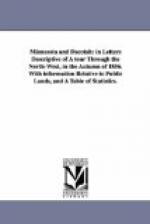[1 “The Hudson’s Bay Company allows its servants, while making a voyage, eight pounds of meat a day, and I am told the allowance is none too much.” (Lieutenant Howison’s Report on Oregon, p. 7.)]
The following extract from Ex-Governor Ramsey’s address, recently delivered before the annual fair at Minneapolis, wherein he gives some results of his observations of the Red River settlement during his trip there in 1851, will be read with much interest:—
“Re-embarking in our canoes, we continued descending the river for some fifteen miles further, through the French portion of the settlement, lining mainly the west or left bank of the river, until we arrived about the centre of the colony, at the mouth of the Assinniboin tributary of Red River, where we landed and remained a few days, viewing the colony and its improvements. I was at that time, and am even now, when I look back upon it, lost in wonder at the phenomena which that settlement exhibits to the world, considering its location in an almost polar region of the North. Imagine a river flowing sluggishly northward through a flat alluvial plain, and the west side of it lined continuously for over thirty miles with cultivated farms, each presenting those appearances of thrift around them which I mentioned as surrounding the first farms seen by us; but each farm with a narrow frontage on the river of only twenty-four rods in width, but extending back for one or two miles, and each of these narrow farms having their dwellings and the farm out-buildings spread only along the river front, with lawns sloping to the water’s edge, and shrubbery and vines liberally trained around them, and trees intermingled— the whole presenting




